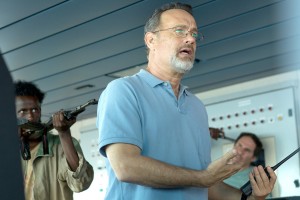Phillips marks triumphant return for Tom Hanks
Anchored by a gripping performance from Tom Hanks and the expert direction of Paul Greengrass, Captain Phillips is a pulsating, attention-grabbing thriller that never lets go, from the tense beginning to the startling conclusion.

Captivating performance · Captain Phillips is based on the memoir of Captain Richard Phillips, played by Hanks (right). The film depicts hostage negotiations between Somali pirates and the Navy for Phillips’ release. – Courtesy of Sony Pictures Publicity
Based on the memoir of Capt. Richard Phillips, who was taken hostage by Somali pirates during the Maersk Alabama hijacking in spring 2009, nearly every element of the feature — from the performances, to the rock-solid screenplay by Billy Ray, to the excellent pacing to the cinematography — helps to create a pressure cooker of a film.
Captain Phillips begins with a very short, but nonetheless important, prologue to introduce and humanize both Phillips and the group of Somali pirates.
Once the prologue ends, the story focuses almost exclusively on the hijacking and the hostage negotiation between the Somalis and the Navy SEALs. The audience never sees the Phillips family’s reaction to the situation or learns about the criticism that Phillips faced for having brought the Maersk Alabama so deep into Somali waters in the first place. For the sake of the film’s pacing, though, this more succinct approach is efficient and effective.
This condensed method syncs very well with the direction of Paul Greengrass, who directed The Bourne Ultimatum and United 93. Though only a few people associate Greengrass with the distinctive, if slightly infamous, shaky-cam cinematography of the Bourne franchise (and subsequent knockoffs), the director shows again in Captain Phillips that he knows when to use that style to benefit the story.
In this film, use of the shaky-cam style isn’t a gimmick. Instead, Greengrass uses it as a filmmaking tool to establish the claustrophobic tone of the film. In the final act, the technique creates a constant tension and helps the audience to get into the mind of Phillips as he desperately tries to keep his crew safe and stay composed under duress.
Even the shaky-cam perspective, however, can’t hide the fact that the first sequence — the hijacking of the Maersk Alabama — is a naturally more tense and compelling act than the next one involving Phillips. In the latter scenario, Phillips is trapped in the pirates’ lifeboat, but because the entire crew is in jeopardy in the former scene, it comes off as more intense.
Despite this small setback, the film’s final hour is nonetheless compelling. The film does an admirable job of showing the level of complexity and delicate maneuvering that the Navy SEALs had to work with to pull off what was considered an exceptionally well-executed operation. One really gets a sense of perspective of just how delicate the margin of error really was during the standout. If the Navy needs another marketing tool, this film certainly fits the bill.
Of course, the Somalis’ desperate efforts to make off with anything for their livelihood also leaves an impression. The portrayal of the Somali pirates is realistic and multi-dimensional; though they are certainly shown as intense and threatening, they’re never shown as sadistic. The film doesn’t get into the politics or the cultural situation that forced these four Somalis to risk their lives, but one can understand and sympathize with their circumstances.
The four actors, who are all Somali nationals, do a good job being fierce but never villainous. The best performance out of the group belongs to Barkhad Abdi and his portrayal of Muse as the desperate yet confident leader of the group. Though he’s the smallest member of the four pirates, his ego and sheer determination drive him to execute on the group’s goal.
Tom Hanks, however, makes the most lasting impression. Hanks holds this film together, as he captures Phillips’ attempt to keep his composure. Hanks hasn’t had this powerful of a performance since Cast Away. He plays Phillips as a white-collared man trying to handle the situation to the best of his ability and attempting to keep the crew of the Maersk Alabama, and even the pirates in the later half of the movie, safe. It’s not a stoic performance — one can see the man is petrified most of the time — but he captures someone who just doesn’t want to see anyone get harmed.
When the finale occurs, Hanks’ reaction is so touching and raw that one can really feel all the pain and shock that Phillips has gone through. It puts into perspective just how rough of an experience Phillips survived in real life. This is definitely an Oscar-caliber performance, though shockingly it might not be the only one Hanks ends up with this year, as he’s also due to portray Walt Disney in the Oscar-baiting Saving Mr. Banks this winter.
A solid production throughout with well-delivered performances, quick pacing, and superb direction, Captain Phillips takes a thrilling true story and captures the raw intensity of the man at the center of it, the pirates who perpetrated it, and the folks who managed to get through a near-impossible standoff. And its inevitable conclusion promises to leave you relieved, exhilarated and maybe even a little startled.
